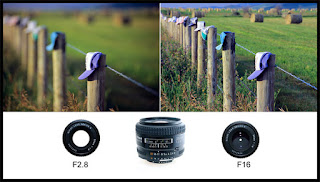What is Aperture, Shutter Speed and ISO?

APERTURE Below, you can see the difference between two photos. One taken with an F16 aperture, while the other taken with an F2.8 aperture. Aperture is usually visualized at a human eye. Our cornea being like the front element of a lens, and aperture controlling how much light is let in, just like our iris in our eyes. The smaller the aperture the less light enters the camera, the larger the aperture, the more light enters the camera. Aperture effects depth of field by changing what the focus in the picture is by lessening or adding F stops. SHUTTER SPEED This is a photo with a high shutter speed. This is a photo with a slow shutter speed. a1) During the day I would've used a high shutter speed so the photo would come out clearly. There would already be enough light from the sun so you wouldn't need more time for the lens to gather light for the photograph. a2) During the night when it is dark I would probably change to a slower shutter speed because ...






